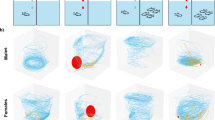Synopsis
To test the hypothesis that minnow alarm substance cells contain a predator deterrent, rainbow trout were offered a choice between fathead minnows with alarm substance cells and fatheads which had been treated with androgen to eliminate alarm substance cells. The trout showed no preference. The testing procedure did detect a preference for liver over commercial pellets.
Similar content being viewed by others
References cited
Boorman, S.A. & P.R. Levitt. 1980. The genetics of altruism. Academic Press, New York. 459 pp.
Harvey, P.H. & P.J. Greenwood. 1978. Anti-predator defence strategies: some evolutionary problems. pp. 129–151.In J.R. Krebs & N.B. Davies (ed.) Behavioural Ecology, Sinauer Assoc., Sunderland.
Kubista, I. 1980. Minnesota bait farmer contributes to multimillion dollar state crop. Aquaculture Magazine 616: 28–30.
Pfeiffer, W. 1974. Pheromones in fish and amphibia. pp. 269–296.In: M.C. Birch (ed.) Pheromones, Frontiers of Biology, Vol. 32, North-Holland Publ., Amsterdam.
Pfeiffer, W. 1982. Chemical signals in communication. pp. 306–326.In: T.J. Hara (ed.) Chemoreception in Fishes, Elsevier, Amsterdam.
Scott, W.B. & E.J. Crossman. 1973. Freshwater fishes of Canada. Fish. Res. Board Can. Bull. 184. 966 pp.
Smith, R.J.F. 1973. Testosterone eliminates alarm substance in male fathead minnows. Can. J. Zool. 51: 875–876.
Smith, R.J.F. 1974. Effects of 17α-methyltestosterone on the dorsal pad and tubercles of fathead minnows (Pimephales promelas). Can. J. Zool. 52: 1031–1038.
Smith, R.J.F. 1982. The adaptive significance of the alarm substance-fright reaction system. pp. 327–342,In: T.J. Hara (ed.) Chemoreception in Fishes, Elsevier, Amsterdam.
Smith, R.J.F. & B.D. Murphy. 1974. Functional morphology of the dorsal pad in fathead minnows (Pimephales promelas Rafinesque). Trans. Amer. Fish. Soc. 103: 65–72.
Thines, G. & J.-M. Legrain. 1973. Effects of alarm substance on the behavior of the cave fish,Anoptichthys jordani andCaecobarbus geertsi. Ann. Speleol. 28: 291–297.
Williams, G.C. 1964. Measurement of consociation among fishes and comments on the evolution of schooling. Publ. Mus. Mich. State Univ. Biol. Ser. 2: 349–384
Author information
Authors and Affiliations
Rights and permissions
About this article
Cite this article
Bernstein, J.W., Smith, R.J.F. Alarm substance cells in fathead minnows do not affect the feeding preference of rainbow trout. Environ Biol Fish 9, 307–311 (1983). https://doi.org/10.1007/BF00692380
Accepted:
Issue Date:
DOI: https://doi.org/10.1007/BF00692380




